COVID-19 testing options are plentiful
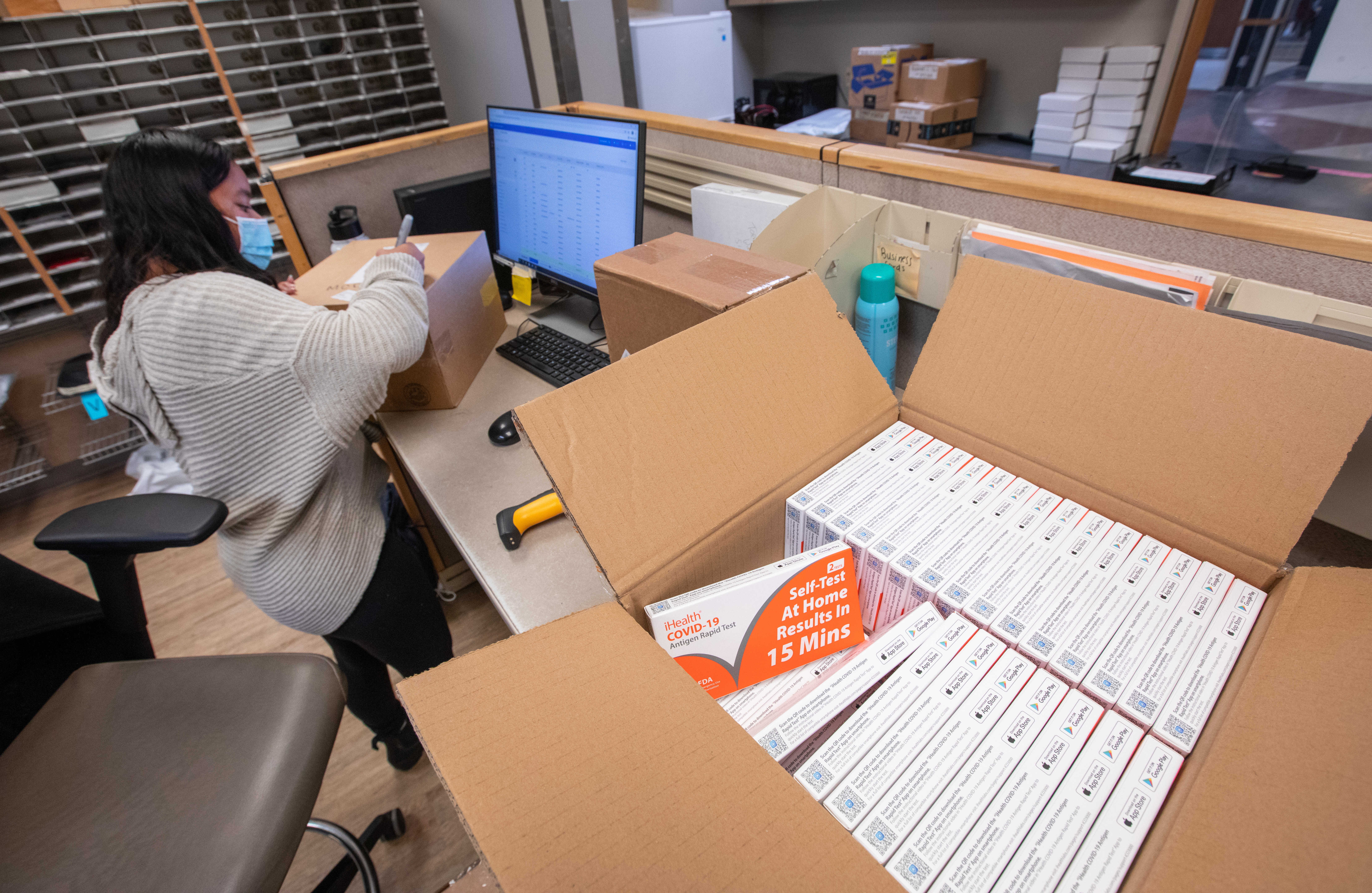
Next to a box of home COVID-19 test kits awaiting distribution, student employee Jalie Shemanski sorts packages inside the Union Drive Community Center mailroom on Jan. 20. ISU employees and students can pick up a free rapid antigen test at five campus locations while supplies last. Photo by Christopher Gannon.
Faculty and staff seeking COVID-19 testing as the omicron wave continues in Iowa have numerous options, including multiple ways to get a free kit to conduct a self-test that provides rapid results.
In-person pickup
Starting last week, employees and students looking to determine if their symptoms are due to a COVID-19 infection can pick up an antigen-based, at-home test at five campus sites:
- Maple Willow Larch hall desk (8 a.m.-6 p.m. weekdays, weekends 1-5 p.m.)
- Memorial Union information desk (7 a.m.-10 p.m. daily, except 11 a.m. opening Sunday)
- Thielen Student Health Center front desk (8 a.m.-5 p.m. weekdays, except 9 a.m. opening Wednesday)
- Union Drive Community Center mailroom (8 a.m.-6 p.m. weekdays, Saturday 1-5 p.m.)
- Vet Med room 2270 (8 a.m.-5 p.m. weekdays)
At the pharmacy
New federal regulations effective Jan. 15 require health insurance plans, including Iowa State’s self-funded employee health insurance, to cover the cost of up to eight rapid antigen tests per rolling 30-day period for each person covered by the plan.
To use this option without making an upfront purchase, select a COVID-19 test at a participating pharmacy and take it to the pharmacy counter (as opposed to the general checkout). Present the Express Scripts card issued with the prescription drug plan included in ISU health coverage. There should be no copay for purchasing a test starting around Feb. 2.
If a copay is charged at a participating pharmacy, submit a claim to Express Scripts for reimbursement. Instructions for claiming reimbursement are online. Manual claims can be submitted via online or paper form. The same process can be used to request reimbursement for the cost of any rapid antigen test purchased on or after Jan. 15, including those bought online. A receipt will be required, and reimbursement is capped at $12 per test ($24 for a box that includes two tests).
By mail
The federal government will send up to four rapid antigen tests to every U.S. household. Request the tests online via the U.S. Postal Service.
Lab tests, too
While the nasal swab at-home antigen tests are effective at detecting COVID-19 in people with symptoms, even more accurate PCR tests also are available.
Test Iowa offers a free saliva-based COVID-19 PCR test. Self-collected samples are submitted to the State Hygienic Laboratory via UPS, and results are available by email within 72 hours of the lab receiving the sample. Kits are available at the same campus locations where rapid tests are distributed.
Hy-Vee continues to operate a drive-thru testing clinic in Lot F, west of Stephens Auditorium, weekdays 9 a.m.-1 p.m., except Wednesdays. Schedule a required appointment online. Lab PCR tests are free and results are available within three to five days. Rapid PCR tests cost $119.
Out-of-pocket costs for COVID testing, including at-home tests, are a medical expense that is eligible for reimbursement by health flexible spending accounts.
Positive test?
See the Moving Forward’s website testing page for guidance on isolation and quarantine.
VanDerZanden reappointed as associate provost
Ann Marie VanDerZanden, associate provost for academic programs and professor of horticulture, has been reappointed to a five-year term beginning July 1. She was first appointed to the role in 2017.
In making the announcement, senior vice president and provost Jonathan Wickert praised VanDerZanden's numerous accomplishments over the last five years, including her leadership during the COVID-19 pandemic.
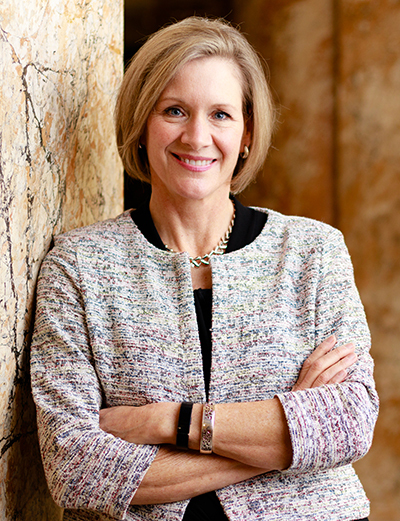
VanDerZanden
"Ann Marie has done a tremendous job sustaining Iowa State's academic mission," Wickert said. "She is a driving force for high quality instruction, student engagement and success, and developing new programs that both satisfy student demand and address the state's workforce needs."
Over the last five years, VanDerZanden has led a broad effort to sustain and improve Iowa State's academic programs. Her achievements include leading the academic continuity working group to address challenges created by COVID-19, co-leading the team that created winter session, completing the university's mid-cycle review from the Higher Learning Commission and working with colleagues on initiatives related to open educational resources, academic advising and online learning. She also works closely with the Faculty Senate on academic policies and processes, including curriculum development.
"It is a privilege to work with so many people on campus who share a common passion for academic excellence and success," VanDerZanden said. "I look forward to continuing this work over my next term to strengthen Iowa State's online capabilities, improve student success in gateway courses, and address equity gaps related to retention and completion."
As associate provost, VanDerZanden provides leadership for Iowa State's academic programs. She facilitates articulation agreements with community colleges and leads university efforts related to accreditation, continuous quality improvement, distance education and international programs. She also has oversight of the program for women in science and engineering, study abroad center and university honors program. She serves as an Iowa State representative to the Business Education Alliance.
A member of the Iowa State faculty since 2003, VanDerZanden has served the university in a variety of roles, including director of the Center for Excellence in Learning and Teaching (2012-17) and co-director of the learning communities program.
A native of Washington, VanDerZanden earned bachelor's and doctoral degrees from Washington State University, Pullman, and a master's degree from Cornell University, Ithaca, New York, all in horticulture. She is a fellow of the American Society for Horticultural Science and a past president of the North American Colleges and Teachers of Agriculture.
World's largest science society honors six researchers for distinguished work
The American Association for the Advancement of Science (AAAS) is honoring six Iowa State researchers for their work in biology, statistics and physics. The six have been elected to the association's 2021 class of 564 AAAS Fellows. They're being recognized "because of their efforts to advance science applications that are deemed scientifically or socially distinguished," the association announced Jan. 26.
"AAAS is proud to bestow the honor of AAAS Fellow to some of today's brightest minds who are integral to forging our path into the future," said Sudip Parikh, chief executive officer of AAAS and executive publisher of the "Science" family of journals.
According to a database kept by the AAAS, since 1910, 146 of its fellows have been elected from Iowa State. Here are the latest six, their award citations and their current research interests:
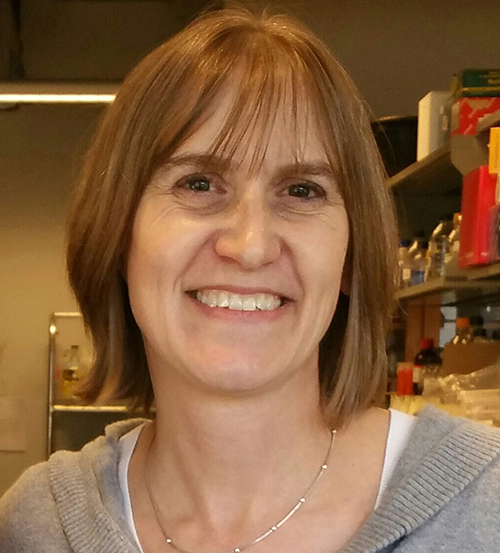
Bassham
Diane Bassham, professor of genetics, development and cell biology and the Walter E. and Helen Parke Loomis Professor of Plant Physiology, "For distinguished contributions to the field of plant cell biology, particularly in studying cellular mechanisms of environmental stress tolerance in plants."
Bassham is identifying the ways plants can respond to and survive environmental stress conditions. She focuses on analysis and manipulation of a pathway that causes plant cells to digest their own components, allowing them to tolerate conditions such as heat, drought and nutrient deficiency.
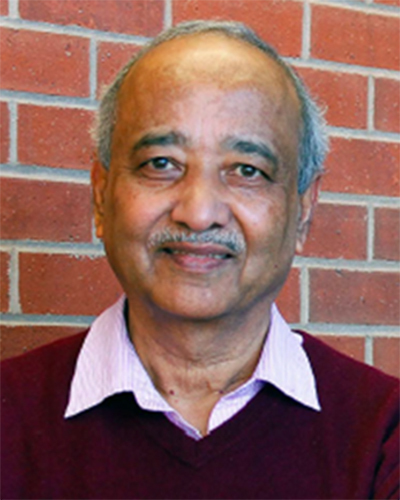
Bhattacharyya
Madan Bhattacharyya, professor of agronomy, "For distinguished contributions to the field of plant-microbe interactions, particularly for understanding the interactions between soybean and its fungal and oomycete pathogens."
Bhattacharyya is using biotechnology to improve soybeans for disease resistance. He has demonstrated that transferring nonhost resistance genes from Arabidopsis, a common model in plant biology, and manipulating expression of soybean genes creates broad-spectrum disease resistance in soybeans. Bhattacharyya's current research also includes investigating the molecular basis of nonhost immunity and broad-spectrum disease resistance.
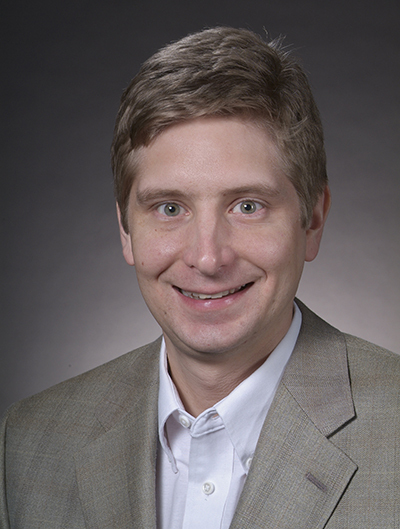
Gassmann
Aaron Gassmann, professor of entomology, "For distinguished contributions to the field of entomology, particularly for advances in understanding the evolution of resistance by insect pests and approaches to delay pest resistance to transgenic crops."
Gassmann's research focuses on interactions between crop plants and insect pests, and approaches for improving agricultural sustainability. In particular, he is interested in factors affecting the evolution of resistance by insect pests to genetically engineered crops that produce insecticidal proteins derived from the bacterium Bacillus thuringiensis (Bt), and ways in which agricultural systems can be managed to delay Bt resistance.
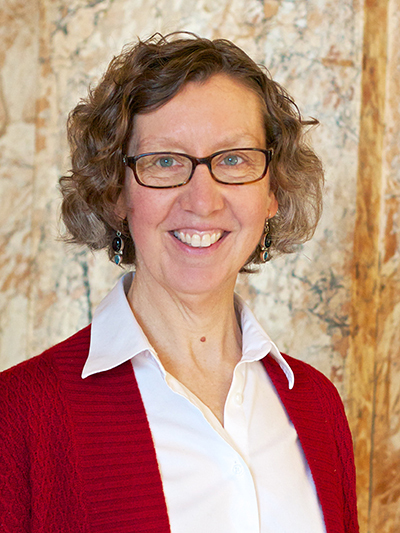
Nusser
Sarah Nusser, former vice president for research and professor emerita of statistics, "For leadership in survey statistics, efforts to improve the reusability and impact of publicly accessible research data, and administrative leadership of research activities."
Nusser's current research focuses on strategies for reducing burden and improving the reusability of publicly accessible research data. This work is part of her broader efforts with the National Academies of Sciences, Engineering and Medicine and the Association of American Universities to promote open scholarship and transparency in research. The work borrows from Nusser's long career in statistical and survey methods for conducting and disseminating data for national surveys. Nusser is also collaborating with a team from the University of Virginia's Biocomplexity Institute to explore the value of curated data resources for U.S. Census Bureau surveys.
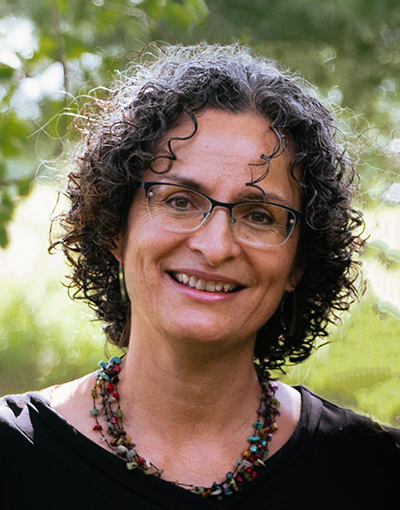
Valenzuela
Nicole Valenzuela, professor of ecology, evolution and organismal biology, "For distinguished contributions to evolutionary biology, with a special focus on understanding the enigmatic phenomenon of temperature-dependent sex determination."
Valenzuela is an evolutionary biologist broadly interested in understanding how ecology affects the structure, function and evolution of the genome and its role in the development and evolution of complex traits, such as sexual development. While Valenzuela continues to study temperature-dependent sex determination, her current work also encompasses research on the evolution of sex chromosomes, genome organization and the development of functional genomic tools for turtles to study biomedical and conservation issues.
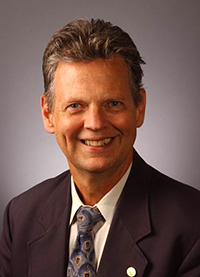
Vary
James Vary, professor of physics and astronomy, "For distinguished contributions to our understanding of nuclear and hadronic structure, creating new computational frameworks for the many-body problem, and for fostering international collaboration in science."
Vary works with Iowa State, national and international collaborators to explore the heart of matter itself -- the nucleus of the atom -- using our knowledge of the fundamental forces of nature. He uses supercomputers to simulate the theoretical properties of the nucleus and compares the results with experiments. His research confirms and sometimes rejects features of the fundamental laws as far as they are known today. In addition, his results sometimes uncover novel phenomena in nature such as his prediction of a state of four neutrons that has possibly been seen in one experiment and is awaiting confirmation in additional experiments.
The AAAS is the world's largest general scientific society and publisher of the journal "Science." Founded in 1848, the association includes more than 250 affiliated societies and academies of science that serve 10 million people.
Pandemic drives up use of instruction apps in Canvas
The pandemic changed the way instructors structured and presented courses to students. Whether they already used Canvas, the university's learning management system (LMS), or started during the transition, it is now a requirement that all courses have a Canvas presence.
To make the most of online learning, Canvas allows instructors to introduce a variety of external tools, content and activities through learning tools interoperability (LTI) or apps.
"We are seeing a dramatic increase in the number of apps that instructors would like to use," said Gretchen Anderson, a Center for Excellence in Learning and Teaching (CELT) instructional technology specialist. "Because we are still in a pandemic, there is that need for flexibility and to pivot quickly. Canvas and its connected apps facilitate that ability."
Connecting Canvas with an LTI ensures the secure transfer of information and improves workflow for tasks like grading assignments. It also ensures students have access to information and course materials.
"Prior to having LTIs, if students had to sign up for content outside of Canvas, inevitably there would be issues with a wrong spelling of a name or another problem," said Angi Beau-Karthik, CELT instructional technology specialist. "Having the LTI makes integration with Canvas seamless, making it easier for the student and instructor."
The apps
Iowa State currently has more than 70 approved LTIs categorized into 18 groups, ranging from collaboration to video recording.
For example, web conferencing tools like WebEx and Microsoft Teams were vital during virtual instruction. Engagement tools like Top Hat allow instructors to present information in different ways, and Respondus LockDown Browser ensures academic integrity during assessments.
Instructors can use improved workflows for course management and grading, and students can obtain course materials numerous ways, including through a Parks Library course reserves LTI. Study tools and writing assistance apps also are available for students.
"Instructors are pleased that they are able to integrate their different learning materials so students don't have to go and search for everything," Anderson said.
Most LTIs are free, but often the content comes with a cost, which is a key consideration when adopting a new LTI.
New LTIs
Publisher-based apps have been heavily requested and reviewed at ISU. Textbook publishers see the benefits of building integrations and have delivered better and easier access to course materials and content students have already published, Anderson said.
Five new apps were added in January, four of which connect to publisher content:
- ALEKS: A research-based, online learning program that offers course materials and assessments
- MyBusinessCourse: Offers print and digital textbooks, instructor supplements and test prep materials.
- MyEducator: Helps track student engagement and course progress.
- GreatRiverLearning: Provides customizable publishing for educators available to students.
The fifth, H5P, is an interactive content application, providing a variety of engaging question types used across the university. It requires a license that has to be purchased.
Looking for an LTI?
Instructors can submit requests for a new LTI to be reviewed via an online form. Each request is reviewed by the LMS enterprise team with representatives from CELT, IT security, university counsel, procurement services and ISU Book Store.
"They are looking for things like security compliance, fit of technology with academic vision, cost and number of students impacted," said Anderson. "The timing of the process varies greatly. It can go as quickly as a week. There is one we have been waiting more than two years because the product was purchased by another vendor and requires updates to be compatible within our system."
As part of the review process, the LTI is installed in Canvas for a test run by the enterprise team and the requester before it is approved. Anderson said many vendors are switching to the newest technology -- LTI Advantage -- which provides better security and options within the LMS.
LTIs are approved for a range of audiences from universitywide down to a single course. New LTIs typically are added at the beginning of a semester to provide students and instructors a consistent environment in Canvas. They are reviewed periodically and can be removed.
If an instructor wants to integrate an LTI, the CELT instructional design team can assist in determining the appropriate one. For help, email celt-help@iastate.edu.
More strides for the faculty mentoring program
Associate teaching professor Claudia Lemper-Manahl, plant pathology and microbiology, signed on as a college peer mentor earlier this month for the College of Agriculture and Life Sciences. She's one of about 18 appointed last spring to a new structure designed to assure some consistency across colleges in the faculty mentoring experience. Not by accident, about 25% of the peer mentors are term faculty like Lemper-Manahl.
Nominate a mentor
Through Feb. 28, the office of the senior vice president and provost is accepting nominations for the Exemplary Faculty Mentor Award, which recognizes excellent mentors who demonstrate extraordinary dedication to the success of their mentee(s). Colleagues who want to nominate their faculty mentor should complete the nomination form (PDF) and email it to exemplary@iastate.edu.
Expectations -- and options -- for term faculty is one of assistant provost for faculty development Tera Jordan's goals for the university's faculty mentoring program. Because mentoring relationships are assigned at the department level and some departments have so few term faculty, one model might not cover it, but Jordan said the colleges were asked for "a concerted effort into options for term faculty" in the next (2022-23) academic year. Those options could be something other than a 1:1 pairing, she noted, and might cross department lines. For example, an Iowa State team led by Jordan this spring is evaluating how other universities have adopted a term faculty learning community model developed at the University of Southern California's Rossier School of Education.
"Our term faculty are such a diverse group, so we're looking at this model for its usefulness to units with one or two term faculty," she said. "If we adopted it at Iowa State, we would need to be careful and intentional about how we might structure it."
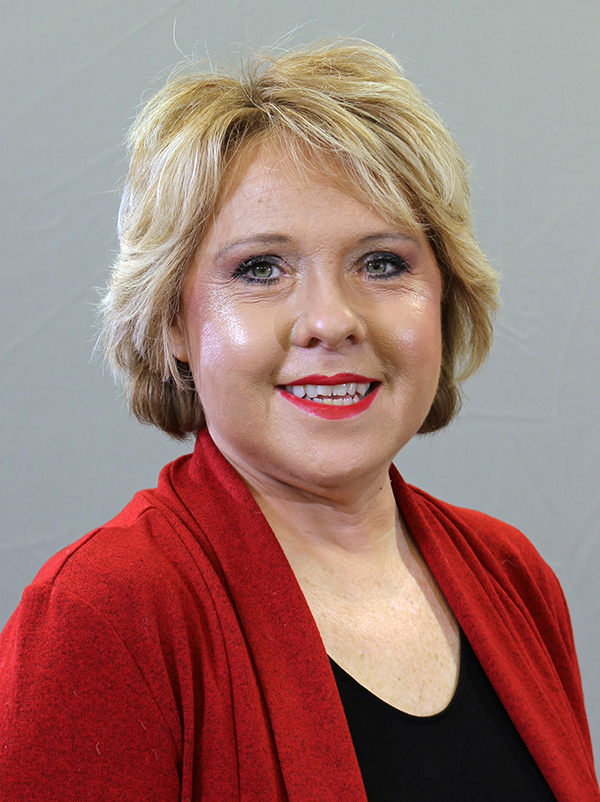
Lemper-Manahl
Lemper-Manahl self-identifies as "a unicorn," one of just two term faculty members in her department. If not for the pandemic's impact on the lab courses she leads, she said she wouldn't have had time to participate in a November 2020 workshop hosted by the provost's office, "Advancing Your Term Career at ISU." Seven years into her faculty teaching position, she first learned about assembling an advancement packet and receiving guidance from a peer. Within a month, the interim department chair had assigned a faculty mentor to her, professor Leanor Leandro. With her insight and guidance, within another month, Lemper-Manahl's packet for advancement to associate teaching professor was on its way for review, and in April she got the good news.
"I want to learn and be part of the change," Lemper-Manahl said about adding the college peer mentor role. "I'm here to help others, and when the college hires more term faculty, I'm going to be right there with them."
Jordan said peer mentors will work with their college administrators to both plan activities for mentored faculty and faculty mentors and, over time, create a more consistent vision for mentoring among the colleges.
"There's work to do, but the goal is it wouldn't matter what college you're in for the ways you're supported and how faculty mentoring operates," she said. "Faculty mentoring provides a check on your scholarship. But it also provides a check on your well-being."
Guidance through the third-year review
The university's recent mentoring model asks academic departments to provide a mentor to new tenure-track faculty for at least the first year of their Iowa State career, and preferably through the junior member's third-year review in the promotion and tenure timeline. Each year, department chairs and school directors match their tenured faculty with incoming tenure-track faculty, and the pairs identify their mutual goals in a mentoring agreement they submit to their college administration office.
The primary goals of faculty mentoring are to increase faculty retention and success, and promote collegiality and inclusion among faculty.
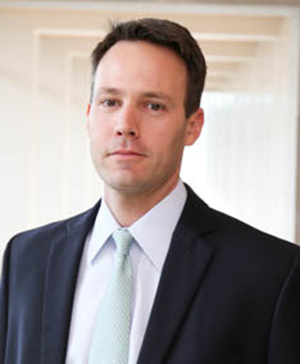
Ralston
Professor of supply chain management Frank Montabon has mentored assistant professor Peter Ralston since Ralston arrived at Iowa State in the fall of 2018, following four years on the faculty at University of West Florida, Pensacola. Ralston earned his Ph.D. in supply chain management from Iowa State in 2014, so he wasn't a stranger to campus. Montabon's biggest gift? Time. Every month, he makes an appointment to come to Ralston's office and talk with him there.
"I'm so thankful for his time and that he made this a priority during the academic school years. It's been invaluable," Ralston said. "Frank has been a fantastic contact and reference to guide me through the institutional policies, but also to just check in on how life is working out."
Over Ralston's three-plus years in the Ivy College of Business, he said the mentoring relationship morphed with his development as a faculty member.
"I appreciate how the relationship has transitioned from getting my feet wet as an Iowa State faculty member and what Iowa State offers to help me be successful, to more of a focus on a long-term successful career," Ralston said. "He's provided insight on what's valued in this department and this college."
Adding value to a Midwest career
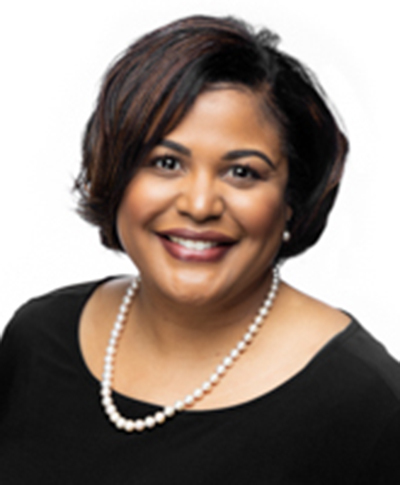
Jordan
At Jordan's direction, Iowa State made strides in the last year to expand the support structure and clarify expectations for mentoring new faculty. In addition to the peer mentor network, those include a three-workshop series that concluded this week, titled Dear Faculty Mentor, and a comprehensive online faculty mentor guide Jordan developed last summer and continues to update.
"We're trying to raise the bar on faculty mentoring at Iowa State," Jordan said. "Across higher education, we know it's not just about the job, but the quality of the experience."
Supporting faculty, especially early in their careers, is part of Iowa State's "value added," she said.
"We have to be intentional about it. And if it's not happening inside our university, if our faculty receive their best mentoring from outside, that's a risk factor for us as a university," she said.
Honesty is the gift
She might not have fully realized it at the time, but assistant professor of marketing Ashley Goreczny's mentoring relationship with associate professor Samantha Cross began before she got to campus in August 2018. Cross, an initial virtual interviewer in the recruiting process, found Goreczny at a conference after she was hired but before she moved to Ames. During Goreczny's family leave in the pandemic, Cross stayed in touch, sometimes a cup of tea and physically-distanced conversation on her front porch.
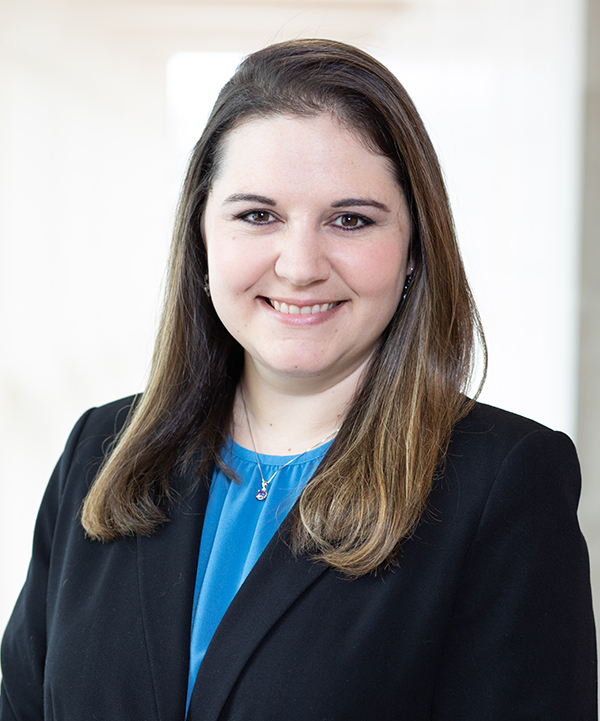
Goreczny
Goreczny receives mentoring from another faculty member whose research better matches hers, but her relationship with Cross continues. For example, following a "highly engaging" department meeting, Cross may ask her if she has questions or wants to talk about anything from the discussion. Goreczny, whose nature is to jump into every opportunity, said Cross also helps keep her focused on priorities: her research, department commitments and how much time to give different ones, and even when it's OK to say "no."
"She really supports me, but the most important thing I appreciate is her honesty with me. Because of that trust, I know I can ask her anything," Goreczny said. "She'll tell me as it is, when I need to hear it.
"I think that's one of the most valuable things a good mentor can do."
Four tips for safe travel across campus this winter
Thirteen inches of snow followed by two days of melting before a deep freeze is hardly a recipe for smooth sailing when walking across campus. Ice has accumulated in spots despite the best efforts of facilities planning and management (FPM) staff.
Since Mother Nature rarely cooperates during Iowa winters, here are four tips for walking to class or exiting a vehicle in a campus lot.
Salt and sand at the ready. Across campus, many building entrances have salt/sand shakers for employees and students to use to treat problem areas. If more salt/sand is needed, call 294-5100.
Know your surroundings. Days are starting to get a little longer bringing more light, but many staff and employees may come and go in the dark.
"Just take a moment before you start walking to observe what is around you," said Steve Couchman, environmental health and safety (EHS) communications manager. "In parking lots, take notice of where snow is piled and know that some may have melted and refrozen over the course of the day. Also avoid shaded areas where ice is more likely to form."
Most people follow the same route to buildings each day, so be aware of any problem areas. Give your full attention to the task and avoid using a phone or other electronic devices until you are indoors.
Dress for the conditions. Proper footwear can make a big difference on slippery surfaces. Give yourself enough time to make it to your destination.
"Give yourself time so you don't have to be rushing on snow or ice," said Heather Simmons, an occupational safety specialist in EHS. "Shoes with good traction help. Avoid wearing dress shoes or heels on days you know there is going to be bad weather."
Simmons said winter is not the time to stray off sidewalks or other designated walking areas to cut through campus to make a walk shorter. What may be more convenient other times of the year can be hazardous during the winter.
Report it. FPM staff work across campus to make travel as safe as possible, but they can't be everywhere. That is where the rest of the campus community can help.
"If people see spots that are consistently icy on their routes, let FPM know so it can be addressed," Simmons said. "I have seen data that most people who slip and fall on campus don't report it, but by letting FPM know -- even if you don't want to report a fall and just a problem area -- staff can address it. It is a partnership, and we are all working together."
Any slick or other concerning areas can be reported to 294-5100.
Simmons takes all information about hazardous area reports and records it on a campus map to better deal with problem spots in the future.
